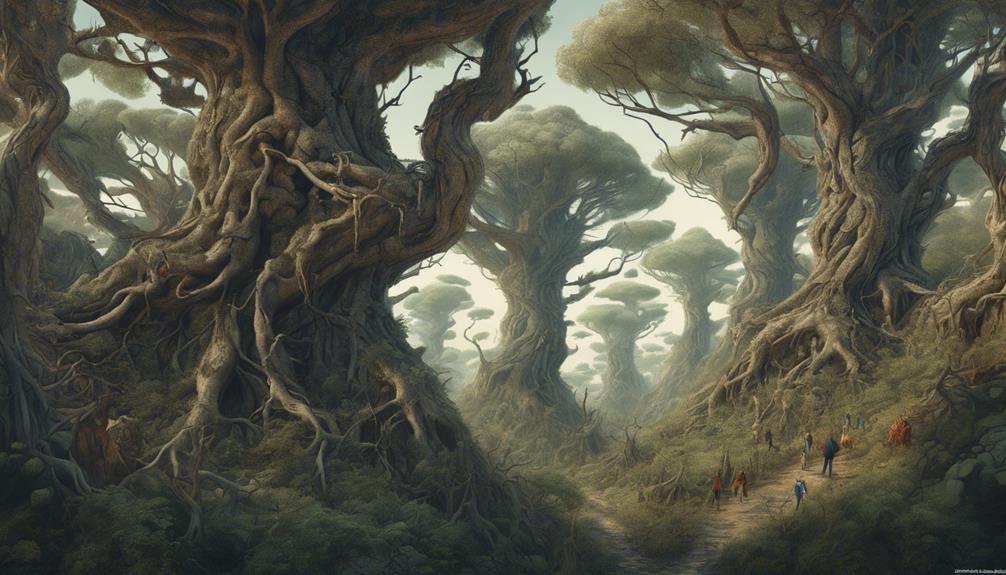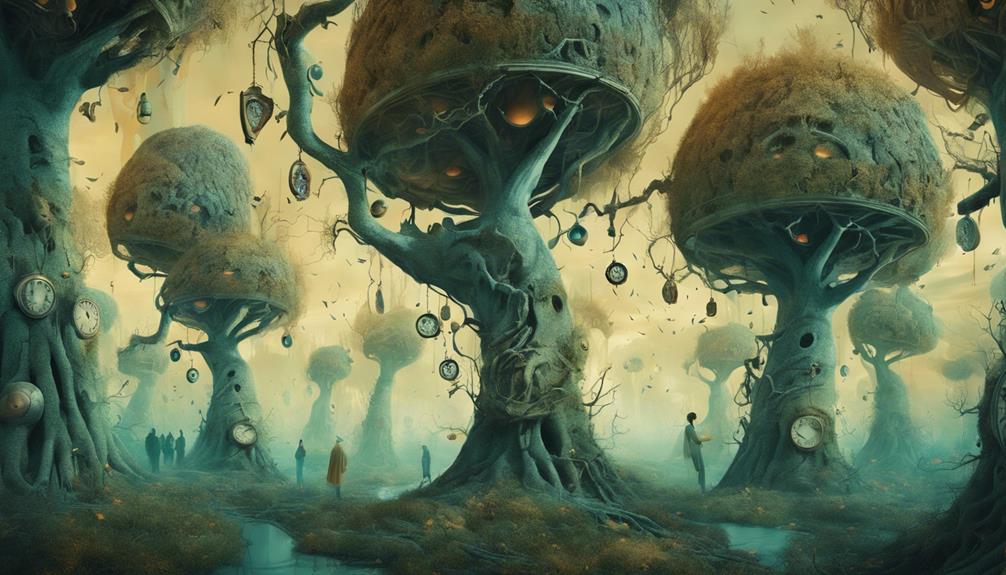Let me pull you into a revelation that transformed my view of art and nature. Max Ernst’s surreal forests have always fascinated me, not just as art, but as gateways to understanding the deeper symbolism of trees. This passion isn’t just about aesthetics; it’s personal. It’s why this topic sings to my soul.
A Journey Through Ernst’s Enigmatic Forests
I remember the first time I stumbled upon Ernst’s work. It felt like discovering a secret language spoken only by the wind in the trees. My blog, Silent Balance, was born from this fascination, aiming to bridge the gap between the ethereal beauty of art and the symbolic significance of nature. The symbolism of trees, in particular, has always resonated with me—how they stand as silent witnesses to the passage of time, embodying strength, growth, and renewal.
Ernst’s paintings, with their twisted, almost sentient trees, spoke to me on a visceral level. They were not simply landscapes; they were narratives waiting to be deciphered, illustrating the complex relationship between humanity and nature. Sharing these insights through Silent Balance has not just been about articulating my thoughts; it’s been a journey of connecting with others who find the same profound beauty in Ernst’s work and the symbolism of trees. This connection, this shared sense of wonder, is why diving into the depths of Ernst’s forests feels like coming home.
Key Takeaways
- Ernst’s surreal forests blend nature and surrealism, revealing subconscious gateways.
- Nature symbolism enriches Ernst’s surreal landscapes, blurring reality and dream.
- Emotional responses emerge from Ernst’s manipulation of perspective in forest portrayals.
- Silent Balance shares enduring wonder of Ernst’s work influenced by nature.
Max Ernst’s Fascination With Trees

Max Ernst’s fascination with trees, deeply rooted in his artistic vision, served as a prominent motif in his surrealist works, symbolizing both the interconnectedness of nature and the subconscious mind. His exploration of tree sculptures and dream landscapes reflected his innovative approach to depicting the complexities of the human psyche.
Through intricate tree sculptures, Ernst conveyed a sense of fluidity and transformation, inviting viewers to explore into the depths of their own subconscious. The dream landscapes he created with twisted branches and surreal forms acted as portals to alternate realities, where logic intertwined with imagination.
Ernst’s trees not only stood as symbols of nature but also as gateways to the mysterious realities of the unconscious mind, inviting contemplation and introspection.
Symbolism of Trees in Ernst’s Work
Within Ernst’s artistic oeuvre, the symbolism of trees emerges as a profound lens through which to explore the intricate tapestry of his surrealist visions. Trees in Ernst’s work represent more than just botanical elements; they embody layers of meaning and depth that enrich his dreamy landscapes.
Here are four key aspects of the symbolic growth of trees in Ernst’s art:
- Roots of Existence: Trees symbolize the deep-rooted connections between nature and the subconscious mind in Ernst’s surreal forests.
- Branching Possibilities: The sprawling branches of trees reflect the endless creative avenues and interpretations present in Ernst’s artworks.
- Seasons of Change: The transformation of trees throughout different seasons mirrors the cyclical nature of life and the artist’s evolving perspectives.
- Sheltering Canopies: Trees act as protective guardians, offering solace and refuge within the whimsical realms of Ernst’s imagination.
The Influence of Nature on Ernst

The profound symbolism of trees in Max Ernst’s surrealist landscapes hints at the significant impact nature had on shaping his artistic vision. Nature played a pivotal role in Ernst’s creativity, serving as a wellspring of inspiration that fueled his artistic process.
Through his deep connection with natural elements, Ernst found a source of raw, untamed beauty that he translated onto canvas with innovative techniques. The organic forms and intricate patterns found in forests and landscapes became the foundation for his imaginative creations.
This intimate relationship with nature not only influenced Ernst’s choice of subject matter but also permeated the essence of his work, infusing it with a sense of wonder and mystery that continues to captivate viewers to this day.
Ernst’s Unique Interpretation of Forests
Ernst’s portrayal of forests in his artworks showcases a distinctive blend of surrealism and natural elements, illustrating his unparalleled vision as an artist. This unique interpretation of forests by Ernst explores into the depths of imagination, where reality and dreams intertwine seamlessly. Through his surreal landscapes, Ernst invites viewers to explore the hidden domains of the subconscious mind, where forests become more than just a backdrop but a reflection of inner thoughts and emotions. His artistic prowess transforms ordinary wooded areas into enchanting settings filled with mystery and intrigue, drawing observers into a world where the boundaries between the tangible and the intangible blur.
- Ernst’s forests as gateways to the subconscious.
- Symbolism of nature in his surreal landscapes.
- Interplay between reality and dream in his forest depictions.
- Ernst’s manipulation of perspective to evoke emotional responses.
Trees as a Reflection of Ernst’s Psyche

In exploring Max Ernst’s portrayal of forests, the intricate depiction of trees emerges as a profound reflection of the artist’s psyche, revealing layers of complexity and symbolism within his surreal landscapes. The tree motifs present in Ernst’s works hold deep psychological symbolism, serving as gateways into Ernst’s inner world. These arboreal expressions go beyond mere botanical representations, delving into the domains of the subconscious and the surreal.
Ernst’s manipulation of tree forms, distortions, and juxtapositions within his forests mirrors the inner turmoil and creative energy of his psyche. Through these symbolic arboreal elements, Ernst invites viewers to unravel the mysteries of his mind, inviting them into a world where nature becomes a mirror of the artist’s deepest thoughts and emotions.
Ernst’s Surreal Forests: A Legacy
Within art history, Max Ernst’s surreal forests stand as a profound proof to the enduring impact of his innovative approach to depicting nature. Ernst’s artistic evolution within surrealism paved the way for future generations of artists to explore the depths of the subconscious mind through their work.
His legacy continues to influence contemporary art, inspiring new interpretations of the natural world through surrealistic lenses. The impact of Ernst’s surreal forests transcends mere visual representation, delving into the territories of psychological exploration and philosophical inquiry.
As viewers engage with Ernst’s forests, they’re invited to question their perceptions of reality and embrace the enigmatic beauty of the surreal. Ernst’s legacy remains a confirmation to the transformative power of art in shaping our understanding of the world.
How Did Max Ernst Find Inspiration in Forests for His Surreal Art?
Max Ernst found inspiration in forests for his surreal art by immersing himself in the natural world, much like the way Ruisdael’s Dutch forests paintings captured the essence of the landscape. The mysterious and dreamlike qualities of the forests fueled Ernst’s imagination, leading to the creation of his iconic artworks.
Conclusion
Max Ernst’s surreal forests continue to enchant art lovers all over, a testament to his genius showcased on our blog Silent Balance. With over 2,000 artworks, Ernst’s passion for nature, particularly his symbolic use of trees, reveals much about his inner world. His surreal forests stand as a vivid testament to his boundless imagination. The symbolism of trees in his paintings opens a window into his soul.
Ernst isn’t the only artist captivated by arboreal beauty; Vincent van Gogh and Gustav Klimt also drew heavily from the serenity and complexity of trees, each adding their distinct flair to this timeless motif.
Have you ever found yourself lost in the brushstrokes of a tree? Share your thoughts below.
Don’t keep this to yourself; spread the word on social media and help Silent Balance grow!
- What Sparked Van Gogh's Obsession With Olive Trees? - March 21, 2024
- Decoding Klimt's Tree of Life: Symbolism Unveiled - March 21, 2024
- Trees: Shaping Mondrian's Abstract Vision - March 21, 2024

